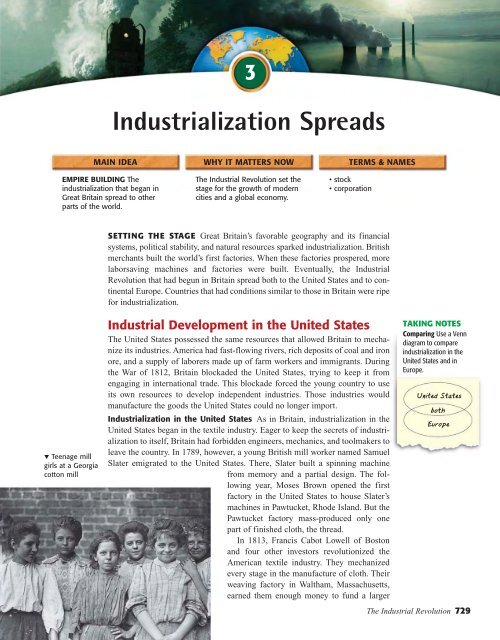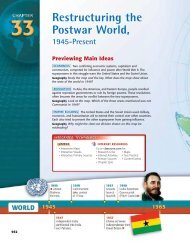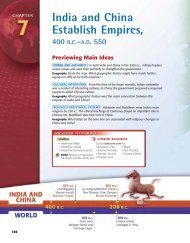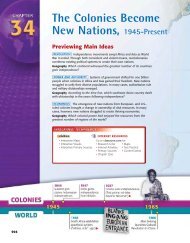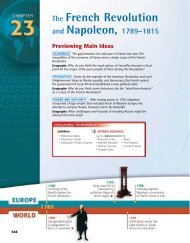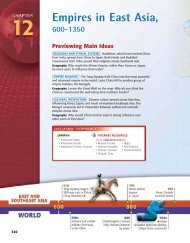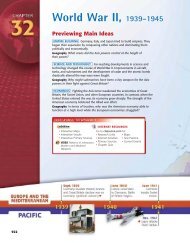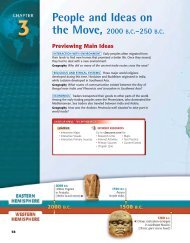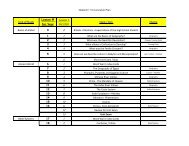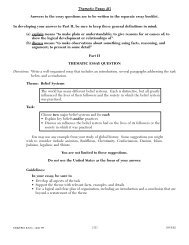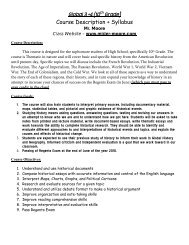The Industrial Revolution, 1700– 1900 Previewing Main Ideas
The Industrial Revolution, 1700– 1900 Previewing Main Ideas
The Industrial Revolution, 1700– 1900 Previewing Main Ideas
Create successful ePaper yourself
Turn your PDF publications into a flip-book with our unique Google optimized e-Paper software.
MAIN IDEA WHY IT MATTERS NOW TERMS & NAMES<br />
EMPIRE BUILDING <strong>The</strong><br />
industrialization that began in<br />
Great Britain spread to other<br />
parts of the world.<br />
▼ Teenage mill<br />
girls at a Georgia<br />
cotton mill<br />
3<br />
<strong>Industrial</strong>ization Spreads<br />
<strong>The</strong> <strong>Industrial</strong> <strong>Revolution</strong> set the<br />
stage for the growth of modern<br />
cities and a global economy.<br />
• stock<br />
• corporation<br />
SETTING THE STAGE Great Britain’s favorable geography and its financial<br />
systems, political stability, and natural resources sparked industrialization. British<br />
merchants built the world’s first factories. When these factories prospered, more<br />
laborsaving machines and factories were built. Eventually, the <strong>Industrial</strong><br />
<strong>Revolution</strong> that had begun in Britain spread both to the United States and to continental<br />
Europe. Countries that had conditions similar to those in Britain were ripe<br />
for industrialization.<br />
<strong>Industrial</strong> Development in the United States<br />
<strong>The</strong> United States possessed the same resources that allowed Britain to mechanize<br />
its industries. America had fast-flowing rivers, rich deposits of coal and iron<br />
ore, and a supply of laborers made up of farm workers and immigrants. During<br />
the War of 1812, Britain blockaded the United States, trying to keep it from<br />
engaging in international trade. This blockade forced the young country to use<br />
its own resources to develop independent industries. Those industries would<br />
manufacture the goods the United States could no longer import.<br />
<strong>Industrial</strong>ization in the United States As in Britain, industrialization in the<br />
United States began in the textile industry. Eager to keep the secrets of industrialization<br />
to itself, Britain had forbidden engineers, mechanics, and toolmakers to<br />
leave the country. In 1789, however, a young British mill worker named Samuel<br />
Slater emigrated to the United States. <strong>The</strong>re, Slater built a spinning machine<br />
from memory and a partial design. <strong>The</strong> following<br />
year, Moses Brown opened the first<br />
factory in the United States to house Slater’s<br />
machines in Pawtucket, Rhode Island. But the<br />
Pawtucket factory mass-produced only one<br />
part of finished cloth, the thread.<br />
In 1813, Francis Cabot Lowell of Boston<br />
and four other investors revolutionized the<br />
American textile industry. <strong>The</strong>y mechanized<br />
every stage in the manufacture of cloth. <strong>The</strong>ir<br />
weaving factory in Waltham, Massachusetts,<br />
earned them enough money to fund a larger<br />
TAKING NOTES<br />
Comparing Use a Venn<br />
diagram to compare<br />
industrialization in the<br />
United States and in<br />
Europe.<br />
United States<br />
both<br />
Europe<br />
<strong>The</strong> <strong>Industrial</strong> <strong>Revolution</strong> 729


